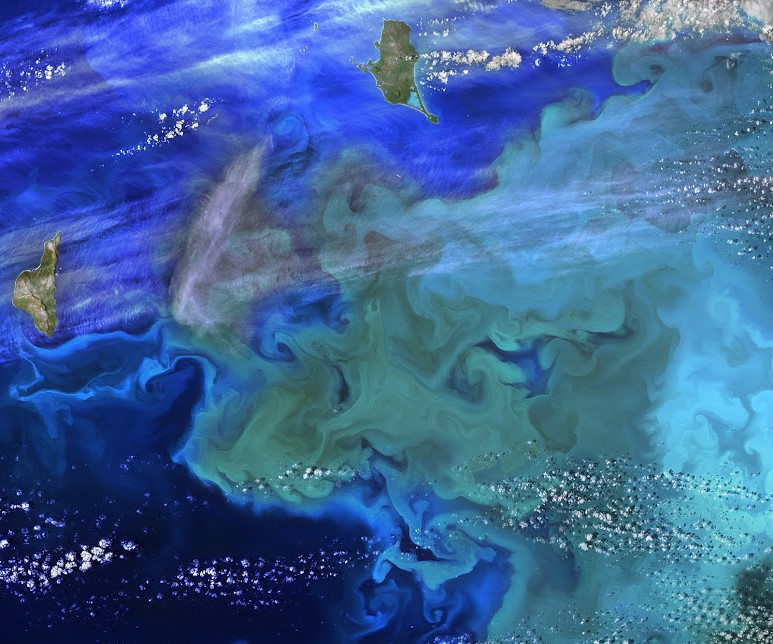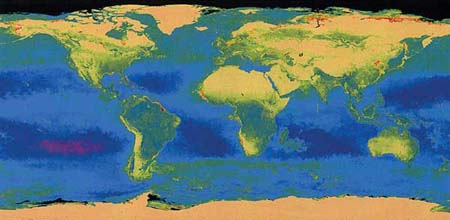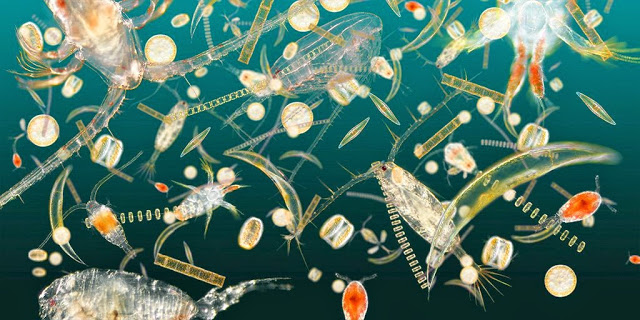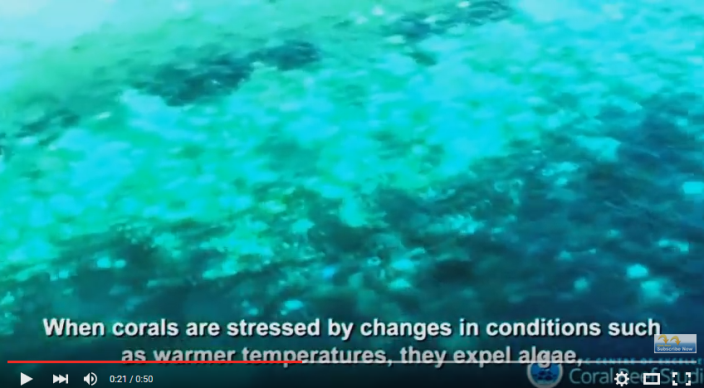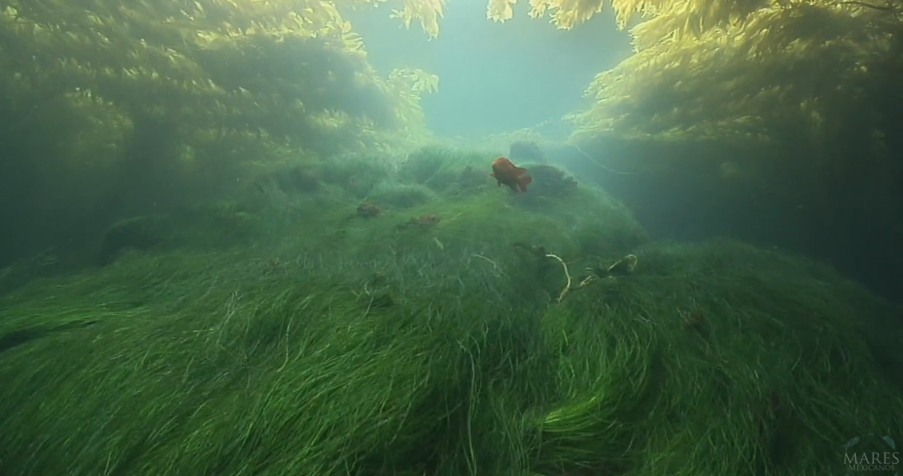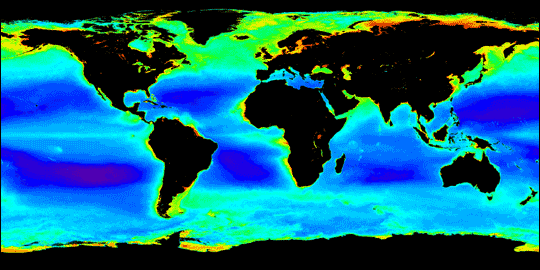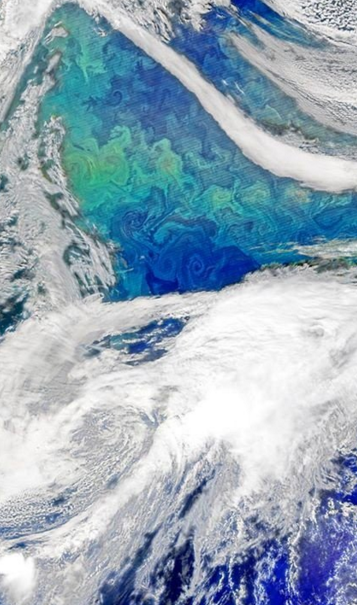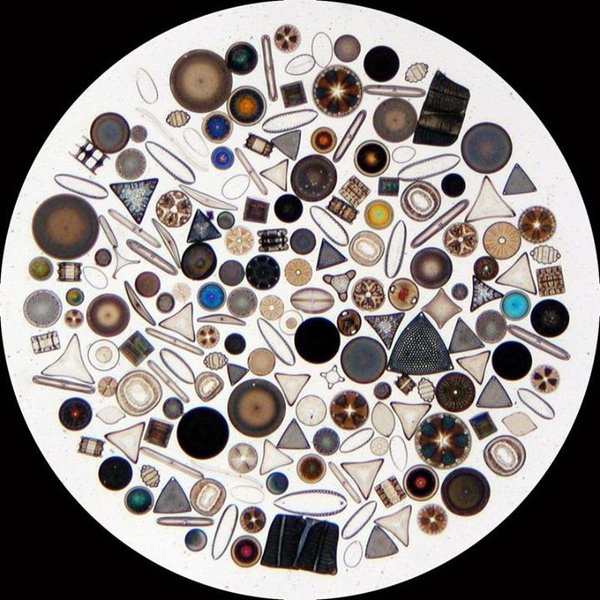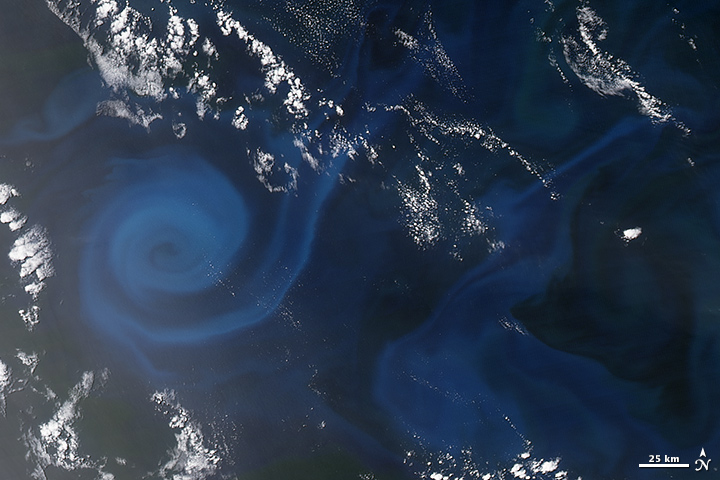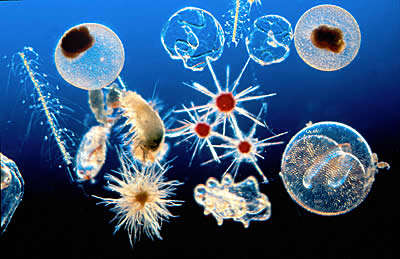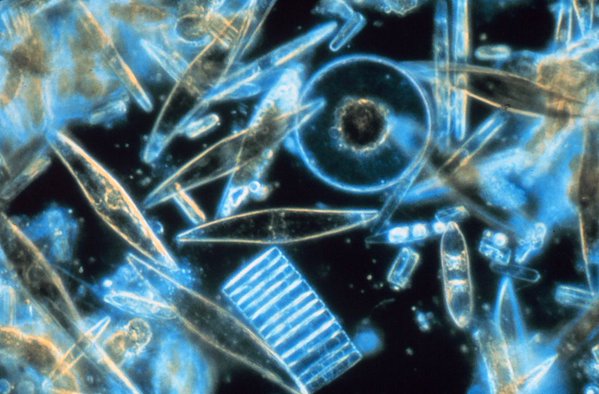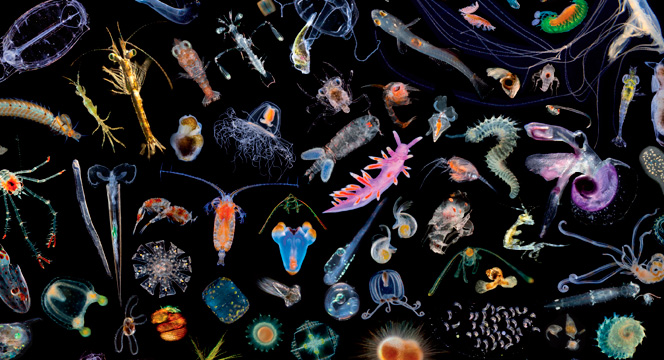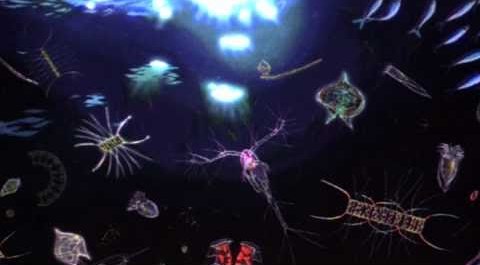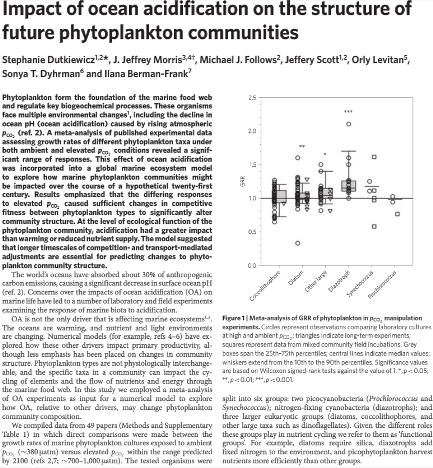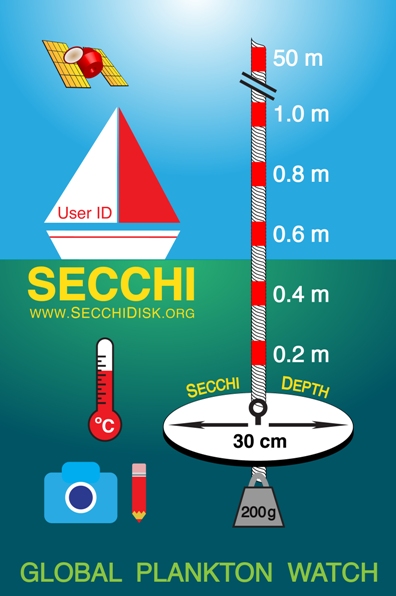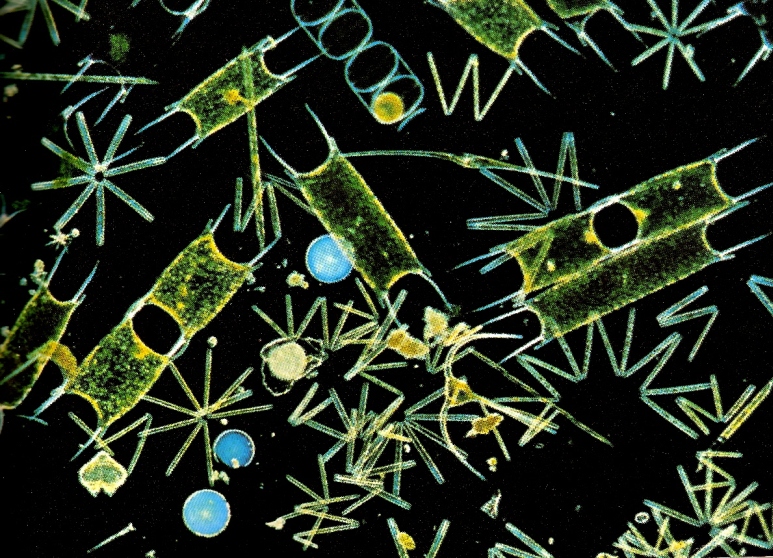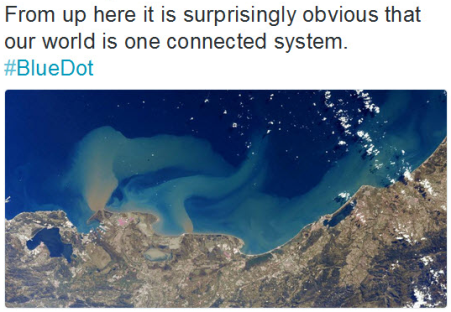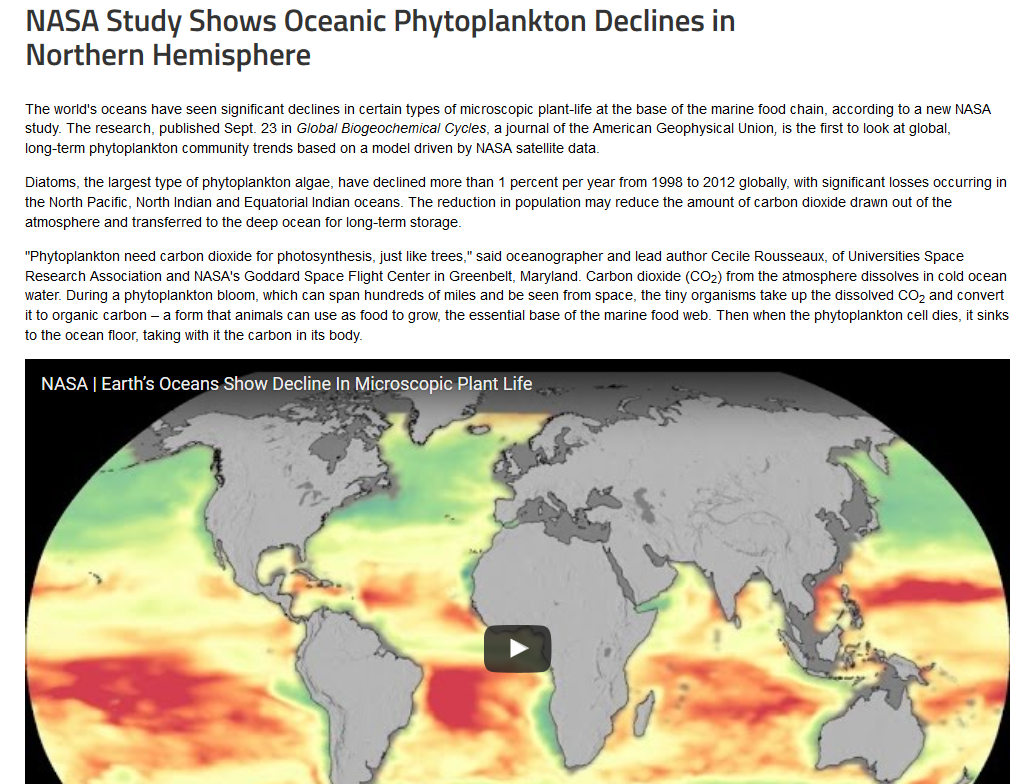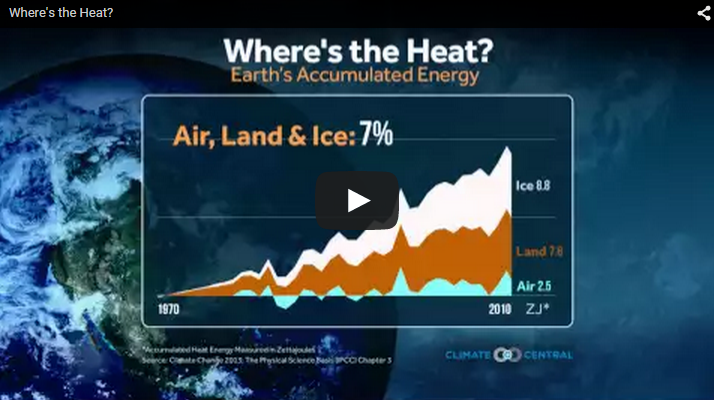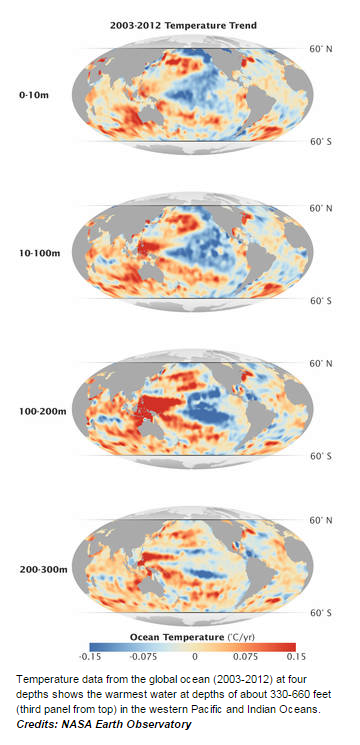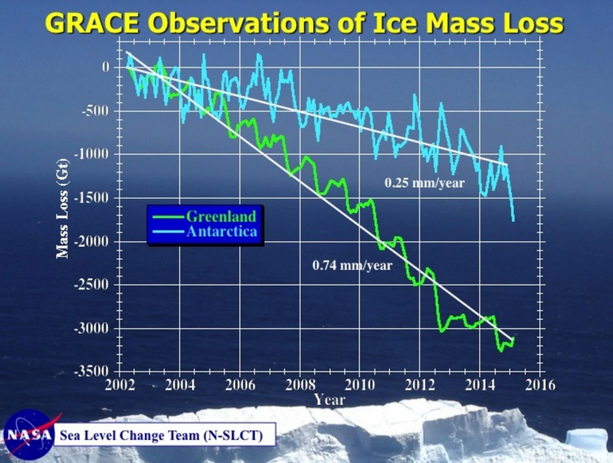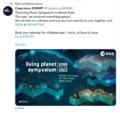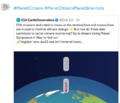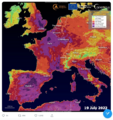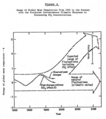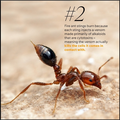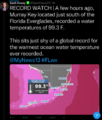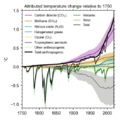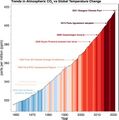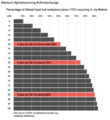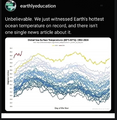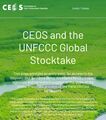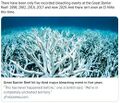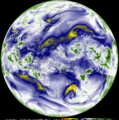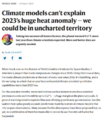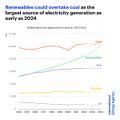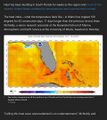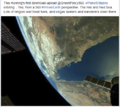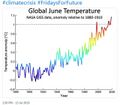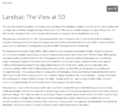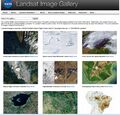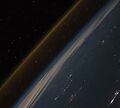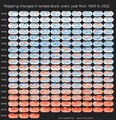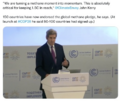Category:Oceans
- "Green" issues make headlines these days, but many seem unaware that without the "blue" there could be no green, no life on Earth
- and therefore none of the other things that humans value.
- Water -- the blue -- is the key to life."
- -- Sylvia A. Earle, "The World Is Blue: How Our Fate and the the Ocean's Are One"
What Price Do We Put on Our Oceans?
● 193 Nations Convene at the December 2017 UN Environment Assembly
● “Political resolve is the key for succeeding in our fight against oceans pollution”
● Oceans are the new economic frontier
● Between 4.8 million tonnes and 12.7 million tonnes of plastic waste enter the ocean every year, 80 percent of it from land sources due to inadequate waste management.
● Why are many law-makers still dragging their feet on strong anti-plastic policies?
● “It’s a case of presenting environmental action in a positive, constructive way. We need to stop looking at it as a cost or sacrifice, but as an opportunity, a win for health, benefits for the economy and for the planet”
- ○ ○ ○ ○ ○ ○ ○ ○ ○ ○ ○ ○ ○ ○ ○ ○ ○ ○ ○ ○ ○ ○ ○ ○ ○ ○ ○ ○ ○ ○ ○ ○ ○ ○ ○
● http://www.biologicaldiversity.org/campaigns/ocean_plastics/
● https://www.greenpolicy360.net/w/The_Commons
● https://www.greenpolicy360.net/w/Category:Oceans
● Plastic in the ocean breaks down into such small segments that pieces of plastic from a one liter bottle could end up on every mile of beach throughout the world.
● Billions of pounds of plastic can be found in swirling convergences in the oceans making up about 40 percent of the world's ocean surfaces. 80 percent of pollution enters the ocean from the land.
● 46 percent of plastics float (EPA 2006) and it can drift for years before eventually concentrating in the ocean gyres.
● The Great Pacific Garbage Patch is located in the North Pacific Gyre off the coast of California and is the largest ocean garbage site in the world. This floating mass of plastic is twice the size of Texas, with plastic pieces outnumbering sea life six to one.
● Plastic constitutes approximately 90 percent of all trash floating on the ocean's surface, with 46,000 pieces of plastic per square mile.
● One million sea birds and 100,000 marine mammals are killed annually from plastic in our oceans. 44 percent of all seabird species, 22 percent of cetaceans, all sea turtle species and a growing list of fish species have been documented with plastic in or around their bodies.
- ○ ○ ○ ○ ○ ○ ○ ○ ○ ○ ○ ○ ○ ○ ○ ○ ○ ○ ○ ○ ○ ○ ○ ○ ○ ○ ○ ○ ○ ○ ○ ○ ○ ○ ○
The Ocean Food Chain
- Blue-Green Life in the Oceans & Connections to Life on Earth
- "A single kind of blue-green algae in the ocean produces the oxygen in one of every five breaths we take"
- ~ from "The World Is Blue: How Our Fate and the Ocean’s Are One" by Sylvia Earle / National Geographic
- "A single kind of blue-green algae in the ocean produces the oxygen in one of every five breaths we take"
- ○ ○ ○ ○ ○ ○ ○ ○ ○ ○ ○ ○ ○ ○ ○ ○ ○ ○ ○ ○ ○ ○ ○
Tiny Blue-Green / Keywords & Focus Areas
- Blue-Green in the Oceans & Connection to Life on Earth
- "The Tiny Little Ones - Plankton"
○
- What's Happening Now in 2016 with the Tiny Blue-Green?
- Coral Reef Ecoregions in Oceans of the World Endangered
- Australia's Great Barrier Reef and Environment in Grave Danger
- Coral reefs in peril as ocean environment is transformed
- Underwater Heat Wave Devastates Great Barrier Reef
- Great Barrier Reef bleaching may be "last wake-up call", marine scientists say
○
- Ocean Grass (Plankton) and Ocean Forests (Kelp)
○
- Science is just beginning to study the role of 'the tiny little ones' in the oceans
- Phytoplankton/Diatoms/Algae -- Microorganisms of the Oceans
- Endangered Tiny-Miniscule Species
- SMALL v LARGE SPECIES
- CO2 Carbon Pollution and Ocean Ecosystems
○
- GLOBAL PLANKTON WATCH
○
- Marine Biodiversity Strongly Linked to Ocean Temperature
- Ocean Temperatures: Are our oceans dying?
- Ocean's Oxygen Starts Running Low
○
- Marine food chains at risk of collapse, extensive study of world's oceans finds
○
- NASA Earth Observatory
○ ○ ○ ○ ○ ○ ○ ○ ○ ○ ○ ○ ○
"The Tiny Little Ones - Plankton"
- "Ecosystems of the Sea"
- Nearly all marine plants are single celled, photosynthetic plankton-algae...
- It is estimated that marine plants produce well over 50% percent of the oxygen in the atmosphere...
- ○
- Olivia's "Prochlorococcus" post --
- ● National Geo for Students: A Message About Saving the 'Little Ones', the Plankton
- Students calculate how many breaths we take each day that come from oxygen produced by (blue-green) phytoplankton
- ● National Geo for Students: A Message About Saving the 'Little Ones', the Plankton
http://www.genomenewsnetwork.org/articles/09_03/ocean.shtml (2003)
Lush tropical rainforests, green prairie pastures and other soil-bound vegetation have long flourished in the ecological limelight. But now the other half of the planet is about to enjoy its day in the sun. Half of the world’s oxygen supply is produced by tiny microbes that live in the sea. And researchers sequencing their genomes have turned up some surprising results... "Photosynthetic organisms in the ocean are as important as photosynthetic organisms on earth... The organisms in the ocean are much less impressive than trees in terms of size, but are extremely important to the biosphere. They produce a significant fraction of the oxygen we breathe, and, fortunately for us, are in less danger than the tropical forests..."
○
New studies are now indicating more danger to ocean photosynthetic organisms...
Recent research shows increasing ecosytems disruption globally. Ocean science is indicating changes to worldwide phythoplankton and the effects of climate change are beginning to be observed by a first-generation of earth/ocean monitoring satellites and 'on Earth' science studies...
Scientific results of 'blue-green monitoring' are cause for serious concern.
○
What's Happening Now in 2016 with the Tiny Blue-Green?
Via Blue Planet:What’s happening to the oceans’ phytoplankton?
Enormous Plankton database
"Ocean's hidden world of plankton: A vital, unseen underwater world"
○
Coral Reef Ecoregions in Oceans of the World Endangered
○
Australia's Great Barrier Reef and Environment in Grave Danger
Coral reefs in peril as ocean environment is transformed
- "Coral Bleaching": Mass expulsion and death of zooxanthellae
○ ○ ○ ○ ○ ○ ○ ○ ○ ○ ○ ○ ○ ○ ○ ○ ○ ○ ○ ○ ○ ○ ○ ○ ○ ○ ○ ○
Underwater Heat Wave Devastates Great Barrier Reef
A Nightmare is Unfolding in the Great Barrier Reef
CANBERRA, Australia — An underwater heat wave is devastating huge swaths of Australia’s Great Barrier Reef, marine researchers have found.
○ ○ ○ ○ ○ ○ ○ ○ ○ ○ ○ ○ ○ ○ ○ ○ ○ ○ ○ ○ ○ ○ ○ ○
Great Barrier Reef bleaching may be "last wake-up call", marine scientists say
Extensive bleaching has been caused by higher ocean temperatures...
○ ○ ○ ○ ○ ○ ○ ○ ○ ○ ○ ○ ○ ○ ○ ○ ○ ○ ○ ○ ○ ○ ○ ○ ○ ○ ○ ○ ○ ○ ○ ○ ○ ○
Australia's Great Barrier Reef hit by severe bleaching - Video
○ ○ ○ ○ ○ ○ ○ ○ ○ ○ ○ ○ ○ ○ ○ ○ ○ ○ ○ ○ ○ ○ ○ ○ ○ ○ ○ ○
Ocean Grass (Plankton) and Ocean Forests (Kelp)
Marine Algae: The Most Important Organism?
It is estimated that marine plants produce more than 50%, up to between 70 and 80 percent of the oxygen in the atmosphere... Nearly all marine plants are single celled, photosynthetic algae... Even marine seaweed is, many times, colonial algae. They are a bunch of single cells trying to look like a big plant ('seaweed' - kelp)... Think about it, 70 percent to 80 percent of all the oxygen we breathe... Why does so much of our oxygen come from algae? First of all, remember that the oceans cover about 71 percent of this planet and land is only about 29 percent... Overall, the production of oxygen in the oceans is at least equal to the production on land
Planet Citizens, Planet Scientists Study Ocean Forests
○ ○ ○ ○ ○ ○ ○ ○ ○ ○ ○ ○ ○ ○ ○ ○ ○ ○ ○ ○ ○ ○ ○ ○ ○ ○ ○ ○ ○ ○
Motion in the Seas (video) by Mares with Phillip Glass music
○
Science is just beginning to study the role of 'the tiny little ones' in the oceans
Removing Carbon, Adding Oxygen: Plankton's Role is Critically Important
http://www.nature.com/nature/journal/vaop/ncurrent/full/nature16942.html
Follow the Tara Expeditions Project
○
Big Trouble Ahead for Ocean Plankton
Why the plankton, then the little fish matter -- http://ocean.si.edu/blog/why-littlest-fish-matter-whole-lot
○
-- 'Prochlorococcus, Tiny Blue-Green Ones'
○
○
Wikipedia References
-- Phytoplankton obtain energy through the process of photosynthesis and must therefore live in the well-lit surface layer (termed the euphotic zone) of an ocean, sea, lake, or other body of water. Phytoplankton account for half of all photosynthetic activity on Earth.
Phytoplankton are responsible for much of the oxygen present in the Earth’s atmosphere – half of the total amount produced by all plant life.
See Prochlorococcus
Cyanobacteria /saɪˌænoʊbækˈtɪəriə/, also known as Cyanophyta, is a phylum of bacteria that obtain their energy through photosynthesis. The name "cyanobacteria" comes from the color of the bacteria (Greek: κυανός (kyanós) = blue). They are often called blue-green algae...
- Cyanobacteria are arguably the most successful group of microorganisms on earth. They are the most genetically diverse; they occupy a broad range of habitats across all latitudes, widespread in freshwater, marine, and terrestrial ecosystems, and they are found in the most extreme niches such as hot springs, salt works, and hypersaline bays. Photoautotrophic, oxygen-producing cyanobacteria created the conditions in the planet's early atmosphere that directed the evolution of aerobic metabolism and eukaryotic photosynthesis. Cyanobacteria fulfill vital ecological functions in the world's oceans, being important contributors to global carbon and nitrogen budgets. See Carbon Sinks
Aquatic cyanobacteria are known for their extensive and highly visible blooms that can form in both freshwater and marine environments. The blooms can have the appearance of blue-green paint...
Cyanobacteria use the energy of sunlight to drive photosynthesis, a process where the energy of light is used to split water molecules into oxygen, protons, and electrons. Because they are aquatic organisms, they typically employ several strategies which are collectively known as a "carbon concentrating mechanism" to aid in the acquisition of inorganic carbon (CO2 or bicarbonate)...
See Diatoms
[Diatoms are] among the most common types of phytoplankton. Diatoms play an important role in biogeochemical earth because they contribute an estimated 75% of primary production in coastal waters... There are more than 200 genera of living diatoms, and it is estimated that there are approximately 100,000 extant species.
○
Sea Drifters (slideshow from BBC - 2010) -- http://news.bbc.co.uk/2/hi/science/nature/8498786.stm
- Close up images of plankton, the tiny creatures that hold the key to survival in the world's oceans
https://www.eoas.ubc.ca/research/phytoplankton/at_a_glance/chain_forming_diatoms.html
Phytoplankton/Diatoms/Algae -- Microorganisms of the Oceans
~ Phytoplankton, photosynthesis, carbon cycle, and oxygen in Earth's atmosphere
○ ○ ○ ○ ○ ○ ○ ○ ○ ○ ○ ○ ○ ○ ○ ○ ○ ○ ○ ○ ○ ○ ○
Endangered Tiny-Miniscule Species
GP360: The standard approach, when looking at threatened species, is to focus on well-known larger species. The Red List is widely known for its work to identify species at risk of extinction. Its work forms the basis for many biodiversity preservation efforts. The focus on [https://en.wikipedia.org/wiki/The_world's_100_most_threatened_species larger, readily identified animals is the norm and these species, often mammals, provides just a part of the larger picture of our threatened environment.
Large 'charismatic', or 'iconic' species, most often eclipse recognition of rarely considered species that are not even 'known' or known to be in danger...
The reality is that much of the extinction in our era is of the small species, the lesser known, unknown and unconsidered species, whether in the rich biospheres of the rainforest or the oceans, the micro-organisms are at risk and in peril of collapse.
When we speak of Plankton, as a profoundly critical keystone species, the food chain of the oceans begins with plankton, yet the disruption of the atmosphere and the heating of the ocean, or acidification, will have great consequences to the Phytoplankon, flagellates who cannot move with their limited locomotion system... Acidification of the oceans and the increases of heat or strengthened suns rays due to changes in atmospheric conditions and UV radiation can have deadly consequences to the 'least of and smallest of' the species -- and as a result effect the larger systems in ways that science is only now beginning to measure and monitor.
We are, our species is, beginning to understand that as the small animals comprising the foundations of the 'food chain' and biosphere systems are disrupted, endangered and/or destroyed, the rest of the food chain and integral ecological connections between species will be disrupted, endangered, and/or destroyed.
The understanding of and protection of biodiversity, large and small, easily recognized and difficult to recognize, is a great challenge of the era in which we live... loss of biodiversity is producing a 'ripple effect' over time, a threat multiplier that demands strategic environmental security as a key goal, a green policy objective beginning with awareness and policies and practices of sustainability.
○
SMALL v LARGE SPECIES
Phytoplankton obtain energy through the process of photosynthesis and must therefore live in the well-lit surface layer (termed the euphotic zone) of an ocean, sea, lake, or other water.
Phytoplankton account for half of all photosynthetic activity on Earth...
Phytoplankton are responsible for much of the oxygen present in the Earth’s atmosphere – half of the total amount produced by all plant life. - http://en.wikipedia.org/wiki/Phytoplankton
○
Marine Biodiversity Strongly Linked to Ocean Temperature
ScienceDaily / 2010 — In an unprecedented effort published online by the international journal Nature, a team of scientists mapped and analyzed global biodiversity patterns for over 11,000 marine species ranging from tiny plankton to sharks and whales.
The researchers found striking similarities among the distribution patterns, with temperature strongly linked to biodiversity for all thirteen groups studied. These results imply that future changes in ocean temperature, such as those due to climate change, may greatly affect the distribution of life in the sea.
http://www.sciencedaily.com/releases/2010/07/100728131707.htm
○
CO2 Carbon Pollution and Ocean Ecosystems
2015 - Big Trouble Ahead for Ocean Plankton
Sobering news: Ocean acidification will likely kill off some phytoplankton species and let others thrive, while warming waters will likely cause mass phytoplankton migrations toward the poles. In short: The base of the marine food web could be in for some serious upheaval in the coming decades. Here’s more from MIT News:
“I’ve always been a total believer in climate change, and I try not to be an alarmist, because it’s not good for anyone,” says (Dr. Stephanie) Dutkiewicz, who is the paper’s lead author. “But I was actually quite shocked by the results. The fact that there are so many different possible changes, that different phytoplankton respond differently, means there might be some quite traumatic changes in the communities over the course of the 21st century. A whole rearrangement of the communities means something to both the food web further up, but also for things like cycling of carbon.”
Dutkiewicz and her colleagues studied 154 published experiments...
GLOBAL PLANKTON WATCH SECCHI DISK
THE GLOBAL SEAFARER STUDY OF THE MARINE PHYTOPLANKTON
ABOUT THE PROJECT
The phytoplankton in the sea account for approximately 50% of all photosynthesis on Earth and, through the food web they support, they underpin the marine food chain.
Living at the surface of the sea the phytoplankton are particularly sensitive to changes in sea surface temperature.
We need to know much more about these changes and you can help by making a simple piece of scientific equipment called a Secchi Disk and using the free Secchi App.
Full instructions for the project are included in the free Secchi App.
Press Release -- Scientists fear the population of the microscopic beings is in decline due to rising sea temperatures and, if true, that could have consequences for every aspect of marine life.
Plankton biologist Dr Richard Kirby, who is leading the study, said: "As the phytoplankton live at the surface of the sea they are being affected by rising sea temperatures due to climate change. A scientific paper published in 2010 suggested the ocean's plankton population had declined by as much as 40 per cent since 1950. Like all marine creatures, phytoplankton have a preferred optimum sea temperature no matter where they are in the world and we need to know more about how they are changing in order to understand the effects on the ocean's biology.” To check the levels of phytoplankton in our oceans, marine experts have developed a free smart phone app for sailors and fishermen to use wherever they are in the world.
Dr Kirby added: "The Secchi Disks are still used by marine scientists to study phytoplankton but there are too few scientists to survey the world's oceans as well as we would wish. This app enables seafarers around the world to take part in a science project and if we can just get a small percentage of the global population of sailors involved, we can generate a database that will help us understand how life in the oceans is changing. It would help us learn much more about these important organisms at a crucial time when their habitat is altering due to climate change."
The Secchi app has been developed by Dr Nicholas Outram and Dr Nigel Barlow, from Plymouth University’s School of Computing and Mathematics, and the database will be maintained by Pixalytics Ltd.
○
Phytoplankton obtain energy through the process of photosynthesis and must therefore live in the well-lit surface layer (termed the euphotic zone) of an ocean, sea, lake, or other body of water. Phytoplankton account for half of all photosynthetic activity on Earth. Thus phytoplankton are responsible for much of the oxygen present in the Earth’s atmosphere – half of the total amount produced by all plant life. (Wikipedia)
○
Marine Biodiversity Strongly Linked to Ocean Temperature
Ocean Temperatures: Are our oceans dying?
"Phytoplankton have declined 40% in 60 years as figures reveal Earth has been getting hotter since the Eighties and much of the heat has been absorbed by oceans...
Microscopic marine algae form the basis of the ocean food chain are dying at a "terrifying rate"...
Phytoplankton, described as the 'fuel' on which marine ecosystems run, are experiencing declines of about 1 per cent of the average total a year...
According to researchers, a 40 per cent drop in phytoplankton since 1950...
Marine diatom cells (Rhizosolenia setigera), an important group of phytoplankton in the oceans are now in massive decline...
The reduction in the amount of algae in the pceams could have an impact on a wide range of species, from tiny zooplankton to marine mammals, seabirds, fish and humans...
The decline of the phytoplankton would be a more dramatic change than the loss of the tropical rainforests, scientist say...
The research, published in the journal Nature, says plankton declines are linked to rising sea-surface temperatures and changes in the conditions of the ocean, particularly close to the equator...
Most of the declines are seen in tropical regions, polar and in the open ocean, where most phytoplankton are produced...
○ ○ ○ ○ ○ ○ ○ ○ ○ ○ ○ ○ ○ ○ ○ ○ ○ ○ ○ ○ ○ ○
Ocean's Oxygen Starts Running Low
Via Grist (2016): Oceans in crisis in as little as 15 years
~ ~ ~ ~ ~ ~ ~ ~ ~ ~ ~ ~ ~ ~ ~ ~ ~ ~ ~ ~ ~ ~ ~ ~ ~ ~ ~
Via Ocean Scientists for Informed Policy: Ocean Deoxygenation
Via AGU / Global Biogeochemical cycles: Finding forced trends in oceanic oxygen
"A major threat to marine life," says NCAR scientist Matthew Long...
Loss of Ocean Oxygen, A 'Forced Trend'
○ ○ ○ ○ ○ ○ ○ ○ ○ ○ ○ ○ ○ ○ ○ ○ ○ ○
Marine food chains at risk of collapse, extensive study of world's oceans finds
Important ecosystems could be massively damaged by 2050 unless greenhouse gas emissions and localised pollution is drastically reduced, researchers say...
The food chains of the world’s oceans are at risk of collapse due to the release of greenhouse gases, overfishing and localised pollution, a stark new analysis shows.
A study of 632 published experiments of the world’s oceans, from tropical to arctic waters, spanning coral reefs and the open seas, found that climate change is whittling away the diversity and abundance of marine species.
The paper, published in the Proceedings of the National Academy of Sciences, found there was “limited scope” for animals to deal with warming waters and acidification, with very few species escaping the negative impact of increasing carbon dioxide dissolution in the oceans.
Published by Nature Climate Change:
- Revaluating ocean warming impacts on global phytoplankton
○ ○ ○ ○ ○ ○ ○ ○ ○ ○ ○ ○ ○ ○ ○ ○ ○ ○ ○
NASA Earth Observatory
Phytoplankton Oxygen Factories
Phytoplankton are the grass of the sea. They are floating, drifting, plant-like organisms that harness the energy of the Sun, mix it with carbon dioxide that they take from the atmosphere, and turn it into carbohydrates and oxygen.
Phytoplankton are critical to the marine food web, being the primary producers of food for the oceanic food web, from zooplankton to fish and shellfish to whales.
Like plants and trees on land, phytoplankton give us a lot more than food. It is estimated that 50 to 80 percent of the oxygen in our atmosphere has been produced by phytoplankton. At the same time, they are responsible for drawing down significant portions of the carbon dioxide from the air. The tiniest of living organisms exert an outsized influence on the planet.
○
Earth Science Research from Space
http://eoimages.gsfc.nasa.gov/images/imagerecords/87000/87465/sepacific_vir_2016013.jpg
○ ○ ○ ○ ○ ○ ○ ○ ○
August 2015/NASA: "What's up with sea-level rise?"
Data from NASA coming i/o from JPL US/Euro mission control
http://www.nasa.gov/goddard/risingseas --- http://svs.gsfc.nasa.gov/cgi-bin/details.cgi?aid=11978 --- https://sealevel.jpl.nasa.gov/ --- http://www.washingtonpost.com/news/energy-environment/wp/2015/08/26/the-troubling-reasons-why-nasa-is-so-focused-on-studying-on-sea-level-rise/ --- https://en.wikipedia.org/wiki/Ocean_Surface_Topography_Mission
Why NASA’s so worried that Greenland’s melting could speed up
○ ○ ○ ○ ○ ○ ○ ○ ○ ○ ○ ○ ○ ○ ○ ○ ○ ○ ○ ○ ○ ○ ○ ○ ○ ○ ○ ○ ○ ○ ○ ○ ○ ○ ○ ○ ○
Global trends show seabird populations dropped 70 per cent since 1950s
“Seabirds are particularly good indicators of the health of marine ecosystems,” said Paleczny. ”When we see this magnitude of seabird decline, we can see there is something wrong with marine ecosystems. It gives us an idea of the overall impact we’re having.”
The dramatic decline is caused by a variety of factors including overfishing of the fish seabirds rely on for food, birds getting tangled in fishing gear, plastic and oil pollution, introduction of non-native predators to seabird colonies, destruction and changes to seabird habitat, and environmental and ecological changes caused by climate change.
Seabirds tend to travel the world’s oceans foraging for food over their long lifetimes, and return to the same colonies to breed. Colony population numbers provide information to scientists about the health of the oceans the birds call home.
http://journals.plos.org/plosone/article?id=10.1371/journal.pone.0129342
_________________________________
Where Is the Heat Going?
http://www.businessinsider.com/ocean-is-absorbing-heat-from-climate-change-2015-8
Here's where over 90% of the extra heat from global warming is going and the billions of dollars it's costing us
Via Business Insider / August 2015
http://www.businessinsider.com/future-marine-life-climate-change-2015-7
_____________________________________________________________________________________
Contrasting futures for ocean and society from different anthropogenic CO2 emissions scenarios
via Science / July 2015
Although the ocean moderates anthropogenic climate change, this has great impacts on its fundamental physics and chemistry, with important consequences for ecosystems and people. Yet, despite the ocean’s critical role in regulating climate—and providing food security and livelihoods for millions of people—international climate negotiations have only minimally considered impacts on the ocean. Here, we evaluate changes to the ocean and its ecosystems, as well as to the goods and services they provide, under two contrasting CO2 scenarios: the current high-emissions trajectory (Representative Concentration Pathway 8.5, RCP8.5) and a stringent emissions scenario (RCP2.6) consistent with the Copenhagen Accord of keeping mean global temperature increase below 2°C in the 21st century. To do this, we draw on the consensus science in the latest assessment report of the Intergovernmental Panel on Climate Change and papers published since the assessment.
ADVANCES
Warming and acidification of surface ocean waters will increase proportionately with cumulative CO2 emissions (see figure). Warm-water corals have already been affected, as have mid-latitude seagrass, high-latitude pteropods and krill, mid-latitude bivalves, and fin fishes. Even under the stringent emissions scenario (RCP2.6), warm-water corals and mid-latitude bivalves will be at high risk by 2100. Under our current rate of emissions, most marine organisms evaluated will have very high risk of impacts by 2100 and many by 2050. These results—derived from experiments, field observations, and modeling—are consistent with evidence from high-CO2 periods in the paleorecord.
Impacts to the ocean’s ecosystem services follow a parallel trajectory. Services such as coastal protection and capture fisheries are already affected by ocean warming and acidification. The risks of impacts to these services increase with continued emissions: They are predicted to remain moderate for the next 85 years for most services under stringent emission reductions, but the business-as-usual scenario (RCP8.5) would put all ecosystem services we considered at high or very high risk over the same time frame. These impacts will be cumulative or synergistic with other human impacts, such as overexploitation of living resources, habitat destruction, and pollution. Fin fisheries at low latitudes, which are a key source of protein and income for millions of people, will be at high risk.
OUTLOOK
Four key messages emerge. First, the ocean strongly influences the climate system and provides important services to humans. Second, impacts on key marine and coastal organisms, ecosystems, and services are already detectable, and several will face high risk of impacts well before 2100, even under the low-emissions scenario (RCP2.6). These impacts will occur across all latitudes, making this a global concern beyond the north/south divide. Third, immediate and substantial reduction of CO2 emissions is required to prevent the massive and mostly irreversible impacts on ocean ecosystems and their services that are projected with emissions greater than those in RCP2.6. Limiting emissions to this level is necessary to meet stated objectives of the United Nations Framework Convention on Climate Change; a substantially different ocean would result from any less-stringent emissions scenario. Fourth, as atmospheric CO2 increases, protection, adaptation, and repair options for the ocean become fewer and less effective.
The ocean provides compelling arguments for rapid reductions in CO2 emissions and eventually atmospheric CO2 drawdown...
○ ○ ○ ○ ○ ○ ○ ○ ○ ○ ○ ○ ○ ○ ○ ○ ○
July 2015
NASA Study Finds Indian, Pacific Oceans Temporarily Hide Global Warming
-- The new study used ocean temperature measurements from a global array of 3,500 Argo floats and other ocean sensors.
-- Temperature data from the global ocean (2003-2012) at four depths
-- Via NASA Earth Observatory http://www.nasa.gov/earth
A new NASA study of ocean temperature measurements shows in recent years extra heat from greenhouse gases has been trapped in the waters of the Pacific and Indian oceans. Researchers say this shifting pattern of ocean heat accounts for the slowdown in the global surface temperature trend observed during the past decade. Researchers Veronica Nieves, Josh Willis and Bill Patzert of NASA’s Jet Propulsion Laboratory (JPL), Pasadena, California, found a specific layer of the Indian and Pacific oceans between 300 and 1,000 feet (100 and 300 meters) below the surface has been accumulating more heat than previously recognized. They also found the movement of warm water has affected surface temperatures. The result was published Thursday in the journal Science.
During the 20th century, as greenhouse gas concentrations increased and trapped more heat energy on Earth, global surface temperatures also increased. However, in the 21st century, this pattern seemed to change temporarily.
"Greenhouse gases continued to trap extra heat, but for about 10 years starting in the early 2000s, global average surface temperature stopped climbing, and even cooled a bit," said Willis.
In the study, researchers analyzed direct ocean temperature measurements, including observations from a global network of about 3,500 ocean temperature probes known as the Argo array. These measurements show temperatures below the surface have been increasing.
The Pacific Ocean is the primary source of the subsurface warm water found in the study, though some of that water now has been pushed to the Indian Ocean. Since 2003, unusually strong trade winds and other climatic features have been piling up warm water in the upper 1,000 feet of the western Pacific, pinning it against Asia and Australia.
"The western Pacific got so warm that some of the warm water is leaking into the Indian Ocean through the Indonesian archipelago," said Nieves, the lead author of the study.
The movement of the warm Pacific water westward pulled heat away from the surface waters of the central and eastern Pacific, which resulted in unusually cool surface temperatures during the last decade. Because the air temperature over the ocean is closely related to the ocean temperature, this provides a plausible explanation for the global cooling trend in surface temperature.
Cooler surface temperatures also are related to a long-lived climatic pattern called the Pacific Decadal Oscillation, which moves in a 20 to 30 year cycle. It has been in a cool phase during the entire time surface temperatures showed cooling, bringing cooler-than-normal water to the eastern Pacific and warmer water to the western side. There currently are signs the pattern may be changing to the opposite phase, with observations showing warmer-than-usual water in the eastern Pacific.
"Given the fact the Pacific Decadal Oscillation seems to be shifting to a warm phase, ocean heating in the Pacific will definitely drive a major surge in global surface warming," Nieves said.
Previous attempts to explain the global surface temperature cooling trend have relied more heavily on climate model results or a combination of modeling and observations, which may be better at simulating long-term impacts over many decades and centuries. This study relied on observations, which are better for showing shorter-term changes over 10 to 20 years. In shorter time spans, natural variations such as the recent slowdown in global surface temperature trends can have larger regional impacts on climate than human-caused warming.
Pauses of a decade or more in Earth's average surface temperature warming have happened before in modern times, with one occurring between the mid-1940s and late 1970s.
"In the long term, there is robust evidence of unabated global warming," Nieves said.
NASA uses the vantage point of space to increase our understanding of our home planet, improve lives and safeguard our future. NASA develops new ways to observe and study Earth's interconnected natural systems with long-term data records.
The agency freely shares this unique knowledge and works with institutions around the world to gain new insights into how our planet is changing.
__________________
Sea-level Rise
○ ○ ○ ○ ○ ○ ○ ○ ○ ○ ○ ○ ○ ○ ○ ○ ○ ○ ○ ○ ○ ○ ○ ○ ○ ○ ○ ○ ○ ○ ○ ○
The ocean and the atmosphere exchange massive amounts of CO2
An anthropogenic flux has been superimposed on the natural flux
http://bit.ly/oceans_acidification
https://en.wikipedia.org/wiki/Ocean_acidification
○ ○ ○ ○
The Darkening Sea by Elizabeth Kolbert
http://www.newyorker.com/magazine/2006/11/20/the-darkening-sea
○ ○ ○ ○
http://www.greenpolicy360.net/w/Anthropocene
○
The World Is Blue
How many ocean species are there?
Not only do we not know, but the answer may be unknowable for the foreseeable future, given the size of the challenge, especially at the microbial level. Even with the ambitious effort of the Census of Marine Life and the combined institutional efforts of various navies, oceanographic research institutions, and individuals, currently less than 5 percent of the ocean has been seen, let along explored; for the deep sea, below 305 meters (1,000 feet), the figure drops to about one percent.
The magnitude of what remains to be discovered is exemplified by the discoveries of Richard Pyle, a truly intrepid biologist who uses cutting-edge re-breather diving systems and special mixes of gases to explore the almost-light/almost-dark region of the sea known as the twilight zone, from 100 to 200 meters (330 to 660 feet) down. He finds new species of fish at the rate of 12 to 13 (and sometimes as many as 30) per hour. For invertebrates, the number is at least ten times that.
Given the number of new forms of life discovered in regions examined for the first time, it is now estimated that the ocean holds at least ten million species. Some believe the number may be closer to a hundred million--not counting the microbes that eclipse all other forms of life in terms of numbers and sheer mass.
○
http://www.greenpolicy360.net/w/Tree_of_Life
The first draft of ‘Tree of Life’ data diagrams include 2.3 million species -- The goal of reconstructing the tree of life is one of the most daunting challenges in biology. The scope of the problem is immense... most species have yet to be described. Despite decades of effort and thousands of phylogenetic studies on diverse clades, we lack a comprehensive tree of life, or even a summary of our current knowledge. One reason for this shortcoming is lack of data...
○
The Oceans, the Commons
https://www.greenpolicy360.net/w/The_Commons
Protect It, Don't Pollute It, Don't Devastate It, Sustain It
https://www.greenpolicy360.net/w/Category:Plastic_Pollution
○
Subcategories
This category has the following 18 subcategories, out of 18 total.
A
B
E
F
G
O
P
S
T
Pages in category "Oceans"
The following 90 pages are in this category, out of 90 total.
C
E
- Earth and Space, Politics
- Earth from NASA
- Earth Imaging-New Space
- Earth Right Now
- Earth Science
- Earth Science Research from Space
- Earth Science Vital Signs
- Ecolivia
- Environmental agreements
- Environmental Law, Rollbacks under Trump 2016-20
- Environmental Laws and Modern Environmental Movement
- Environmental movement
- Environmental protection
- ESA Living Planet Announcement - May 2022
- European Union Green Deal - Fit for 55
- Extinction
G
- George E. Brown Jr
- Glasgow Climate Summit - Pledges, Promises, Declarations - What's Next Up
- Global Fishing Watch
- Google Earth
- Google Earth Timelapse
- GP360 NewPages
- Green Politics 360
- Green Stories of the Day
- Green Stories of the Day - GreenPolicy360 Archive
- GreenPolicy360 Archive Highlights 2013
- GreenPolicy360 Archive Highlights 2014
- GreenPolicy360 Archive Highlights 2015
- GreenPolicy360 Archive Highlights 2016
- GreenPolicy360 Archive Highlights 2017
- GreenPolicy360 Archive Highlights 2018
- GreenPolicy360 Archive Highlights 2019
- GreenPolicy360 Archive Highlights 2020
- GreenPolicy360 Archive Highlights 2023
- GreenPolicy360 Highlights
L
P
S
T
V
Media in category "Oceans"
The following 200 files are in this category, out of 691 total.
(previous page) (next page)- EO and Fire Ants in the US - on World Wildlife Day.png 768 × 811; 663 KB
- EPA History Xin Liu-2010.pdf ; 2.88 MB
- ESA Living Planet Symposium - Announcement.png 637 × 600; 508 KB
- ESA Living Planet Symposium - May 2022.png 700 × 600; 258 KB
- ESG Fight - Feb 2023.png 396 × 194; 88 KB
- Estates at Acqualina - Sunny Isles Miami.jpg 746 × 600; 117 KB
- Estuary in Clearwater on Tampa Bay.jpg 3,584 × 2,016; 1.5 MB
- EU agrees to cut emissions 55 percent by 2030.jpg 800 × 558; 96 KB
- EU unveils new climate change policy - July 14 2021 - 1.jpg 800 × 234; 33 KB
- EU unveils new climate change policy - July 14 2021 - 2.jpg 800 × 552; 86 KB
- EU unveils new climate change policy - July 14 2021 - 3.jpg 800 × 549; 89 KB
- EU unveils new climate change policy - July 14 2021 - 4.jpg 800 × 550; 92 KB
- EU unveils new climate change policy - July 14 2021 - 5.jpg 800 × 548; 88 KB
- EU unveils new climate change policy - July 14 2021 - 6.jpg 800 × 557; 89 KB
- EU unveils new climate change policy - July 14 2021 - 7.jpg 800 × 553; 92 KB
- EU unveils new climate change policy - July 14 2021 - 8.jpg 800 × 589; 91 KB
- Eukaryotic Cell SCU.jpg 716 × 1,024; 799 KB
- Eunice Foote Illustration climate.gov.jpg 620 × 296; 55 KB
- Europe heat wave - July 19 2022 - via Copernicus satellite.png 600 × 639; 704 KB
- Extreme temperature-world-May 2024.jpg 640 × 427; 105 KB
- ExxonMobil CO2 climatic response study - Graphic 1 - 1982.png 537 × 680; 150 KB
- ExxonMobil CO2 climatic response study - Graphic 2 - 1982.png 537 × 605; 112 KB
- FaceApp Florida.jpg 640 × 428; 40 KB
- Fact Checking organizations at work.jpg 800 × 390; 44 KB
- Facts about US Energy Use.jpg 697 × 600; 101 KB
- Facts Count-WaPo Reports-19127 false-misleading claims in 1226 days.jpg 601 × 489; 100 KB
- Fire Ants.png 601 × 600; 603 KB
- Floating adaptations - GCA - for sea-level rise - circa 2023.png 600 × 732; 273 KB
- Floating forest of kelp.jpg 940 × 263; 61 KB
- Floating Forest Project .png 773 × 461; 932 KB
- Floating Forest Project.png 1,106 × 604; 1,020 KB
- Floating Forests-Kelp -- Oceanlight.jpg 720 × 480; 137 KB
- Flooding in South Florida.png 640 × 742; 293 KB
- Florida 2024 Heating up and upset.jpg 460 × 581; 89 KB
- Florida and climate change denial.png 640 × 192; 46 KB
- Florida governor and legislature strike climate science - 2024.png 640 × 105; 42 KB
- Florida Keys sea surface temps for 2023 (as of July).png 480 × 585; 287 KB
- Florida ocean water temp south of Everglades tops 99 F. degrees.png 480 × 564; 128 KB
- Florida sea surface water in the Keys area tops 100 degree F.jpg 640 × 257; 58 KB
- FOOD.jpg 983 × 311; 117 KB
- Fox on Earth Day 2023.jpg 640 × 275; 58 KB
- From 1968 to 1992 -- and the Journey continues....png 572 × 851; 320 KB
- From Laudato Si protecting diversity of life.jpg 800 × 784; 118 KB
- From Reid Wiseman Earth Ocean Patterns.png 941 × 578; 715 KB
- G Earth Outreach.jpg 800 × 412; 44 KB
- Gavin in Glasgow - Nov 10 2021.png 728 × 600; 378 KB
- George Brown, Sci Com't.jpg 200 × 200; 7 KB
- GHG forcings 1750-2020.png 531 × 531; 94 KB
- GHG ppt concentrations 1975-2020.jpg 640 × 361; 69 KB
- Gistemp 1979-2019.png 750 × 491; 335 KB
- Glasgow-Climate Conference News-Nov 6, 2021.png 600 × 800; 290 KB
- Global Biodiversity Information-Data.png 501 × 266; 124 KB
- Global Changes in temperature 1850-2020.jpg 480 × 480; 152 KB
- Global Climate Change textbook-Edition2.jpg 604 × 680; 96 KB
- Global climate conferences and GHG increases.jpg 793 × 801; 56 KB
- Global Climate Dashboard - NOAA - Climate.gov.png 630 × 480; 165 KB
- Global climate dashboard-NOAA climate.gov.jpg 521 × 221; 45 KB
- Global climate dashboard-www.climate.gov.jpg 800 × 489; 100 KB
- Global Climate Dashboard.jpg 800 × 529; 101 KB
- Global Climate Strike - RU.jpg 450 × 804; 116 KB
- Global Fishing Watch 2.jpg 266 × 247; 26 KB
- Global Fishing Watch.jpg 1,246 × 569; 205 KB
- Global Fossil CO2 Emissions 1960-2024.jpg 680 × 383; 30 KB
- Global fossil fuel emissions - in a lifetime graphic.png 600 × 657; 233 KB
- Global Green New Deal.jpg 427 × 640; 32 KB
- Global greenhouse gas emissions - 1980 - 2020.png 640 × 480; 158 KB
- Global Primary Energy Consumption - 1800-2017.jpg 800 × 583; 65 KB
- Global sea surface temperature 1982-2024.png 800 × 823; 566 KB
- Global sea surface temperature graph as of 2024.png 800 × 455; 654 KB
- Global Stocktake, the first GST.jpg 800 × 905; 513 KB
- Global temperature change 1850-2016.gif 512 × 288; 1.38 MB
- Global temperature change 1901-2000.jpg 640 × 508; 47 KB
- Global temperature variations over past 200 years.jpg 640 × 360; 29 KB
- Global warming June 2024.jpg 640 × 174; 46 KB
- GlobalFishingWatch.jpg 577 × 820; 302 KB
- Good science needs good data .png 579 × 420; 223 KB
- Google Earth Hello2.png 800 × 375; 863 KB
- GP360 tagcloud2 m.png 531 × 324; 132 KB
- Great Barrier Reef - March 2020.jpg 800 × 296; 86 KB
- Great Barrier Reef 2020.jpg 517 × 445; 107 KB
- Great Barrier Reef dying.jpg 1,920 × 1,280; 706 KB
- Great Barrier Reef severe bleaching die-off.png 704 × 388; 630 KB
- Great-barrier-reef-2011 image credit, mike mccoy.jpg 2,560 × 1,600; 3.91 MB
- Greenhouse gas levels hit record - Reuters.jpg 600 × 696; 104 KB
- Greenland ice sheet set to raise sea level significantly.png 640 × 340; 223 KB
- GreenPolicy360 - May- 9-2024.png 800 × 406; 119 KB
- GreenPolicy360 - May-10-2024.png 790 × 694; 320 KB
- Greta - the politics thats needed.jpg 639 × 203; 38 KB
- Greta anger into action.png 800 × 419; 528 KB
- Greta Looks Back.PNG 504 × 437; 368 KB
- Greta Thunberg - Week 203 Climate Strike Banner.png 209 × 127; 51 KB
- Greta Thunberg - Week 203 Climate Strike.png 554 × 601; 488 KB
- Group on Earth Observations.JPG 546 × 418; 33 KB
- Guarding Earths Water - from Space.jpg 578 × 496; 102 KB
- Gulf Stream in Critical Danger.pdf ; 181 KB
- Haiku poems - Owl against a dusk sky - via Haiku Foundation.png 514 × 413; 144 KB
- Haikubox via RM citizen science.png 600 × 640; 466 KB
- Hansen testimony WaPo front page.jpg 480 × 210; 40 KB
- Hansen-testimony-1988.jpg 350 × 257; 42 KB
- Heat hitting billions.png 614 × 690; 509 KB
- High Seas Treaty agreement - March 4 2023.png 617 × 498; 53 KB
- Himawari Earth water vapor dynamics.png 768 × 774; 917 KB
- Historic climate-clean energy vote in US Congress August 12 2022.jpeg 800 × 775; 384 KB
- Historic gulf of mexico warm water.png 800 × 306; 148 KB
- Historic heat in gulf of mexico.png 800 × 810; 590 KB
- Historic photographs - Humble Oil TX - Exxon.png 591 × 596; 548 KB
- House passes biggest climate investment in U.S. history.png 625 × 480; 114 KB
- How satellites monitor climate change circa 2016.png 599 × 327; 0 bytes
- Huge heat anomaly in 2023 - by Gavin Schmidt.png 735 × 857; 172 KB
- Hurricane Michael October 2018.jpg 600 × 314; 48 KB
- Hurricane-Proofing-Home-2024-Miami-Florida.png 658 × 600; 652 KB
- Hurricanes - Typhoons via NASA data.png 764 × 924; 1,022 KB
- I Am Greta - the Documentary.jpg 387 × 485; 30 KB
- I Am Greta Marching.jpg 800 × 534; 80 KB
- IEA - Support for Fossil Fuels - re 2021.jpg 559 × 800; 143 KB
- IEA energy chart - 2023.jpg 600 × 600; 68 KB
- IEA News 1.jpg 480 × 400; 64 KB
- IEA News 2.jpg 480 × 475; 55 KB
- IEA News 3.jpg 480 × 496; 57 KB
- IEA News 4.jpg 480 × 530; 57 KB
- IEA News 5.jpg 480 × 539; 62 KB
- IMO Headquarters - photo via NYT.jpg 237 × 368; 22 KB
- In nature, nothing exists alone.jpg 500 × 357; 26 KB
- In the smallest creatures god.png 748 × 149; 232 KB
- INaturalist butterfly.jpg 1,024 × 683; 202 KB
- Infrastructure Bill and Climate Resilience - A Step Forward.png 640 × 403; 526 KB
- Intertidal Zone.png 800 × 474; 489 KB
- Interview w Mayor of South Miami 2.png 749 × 387; 289 KB
- Invading Seas warning 2024.png 757 × 587; 669 KB
- IPCC Report - Feb 2022.jpg 448 × 291; 113 KB
- IPCC report August 9-2021 (1).jpg 745 × 380; 156 KB
- IPCC report August 9-2021 (2).jpg 745 × 428; 171 KB
- It's hot in South Florida - July 2023.jpg 480 × 537; 92 KB
- It's Hot the Times UK Says... Act Now or else - July 2022.png 800 × 416; 568 KB
- James Hansen 2024.jpg 600 × 658; 110 KB
- January-May 2020 temp anomaly.jpg 680 × 380; 54 KB
- Jason2.jpg 416 × 200; 61 KB
- Jason3-16-2.jpg 600 × 236; 54 KB
- Jerry Brown re EPA - 19 June 2019.jpg 699 × 798; 126 KB
- Joe Biden is projected winner Nov7-2020.jpg 343 × 120; 26 KB
- John Kerry - Climate Envoy - 2021-09-26.png 640 × 410; 349 KB
- Journey of a Climate Pixel - May 2022.png 800 × 399; 114 KB
- July 14, 2018 - hello down there.png 524 × 467; 290 KB
- June 2019 - NASA GISS data - hottest on record.jpg 640 × 560; 58 KB
- Katharine Hayhoe - Nov 26, 2019.jpg 508 × 466; 80 KB
- Kelp forest off Calif coast collapsing.jpg 773 × 681; 155 KB
- Kelp NOAA credit Robert Schwemmer.jpg 450 × 299; 193 KB
- Kim Cobb - Georgia Tech professor of climate science.jpeg 800 × 533; 87 KB
- LA Times - July 2023 on the world's response to the climate crisis-1a.png 800 × 1,011; 657 KB
- LA Times on the world's response to the climate crisis-2.png 800 × 651; 297 KB
- LA Times on the world's response to the climate crisis-3.png 800 × 806; 302 KB
- LA Times on the world's response to the climate crisis-4.png 800 × 896; 321 KB
- LANDSAT - NASA.jpg 622 × 415; 95 KB
- Landsat 50th anniv Sept 2016.jpg 800 × 456; 94 KB
- Landsat 9 about to launch.png 420 × 721; 355 KB
- Landsat 9 Launches - 1.jpg 600 × 693; 128 KB
- Landsat 9 Launches - 2.jpg 600 × 737; 250 KB
- Landsat at 50.png 800 × 713; 345 KB
- Landsat Image Gallery.jpg 800 × 766; 187 KB
- Landsat memories.png 535 × 473; 159 KB
- Launch into Space.jpg 800 × 717; 50 KB
- LDCs face the climate crisis, raise the alarm - Nov 2021.png 419 × 226; 126 KB
- Le Grand Bleu.png 738 × 1,107; 1.52 MB
- Leah Stokes - UCSB - Prof Climate and Energy Policy.png 640 × 476; 295 KB
- Living Earth.png 441 × 183; 106 KB
- Living-Shoreline.png 800 × 367; 128 KB
- LivingEarth2.png 800 × 503; 478 KB
- LivingShorelines Graph.png 680 × 375; 73 KB
- LMDCs make their case at the Glasgow climate summit.png 427 × 480; 259 KB
- Manchin kills the Biden climate plan.jpg 800 × 438; 71 KB
- Manchin News - Dec 20 2021.png 600 × 588; 307 KB
- Manchin News 2 - Dec 20 2021.png 600 × 600; 329 KB
- Mangroves 'green wall' in China.png 600 × 600; 466 KB
- Mangroves regulate flooding - EDF.png 568 × 473; 328 KB
- Map of the World wiki commons m.png 679 × 314; 18 KB
- Map of the World wiki commons s.png 339 × 157; 13 KB
- Map of the World wiki commons.png 1,357 × 628; 19 KB
- Mapping changes in global temperature 1850-2022.png 656 × 680; 180 KB
- Mapping the Earth with Google Earth Outreach.jpg 640 × 648; 109 KB
- Mar a lagoon tba.jpg 540 × 405; 40 KB
- March for Science-1.png 800 × 291; 596 KB
- Mares Kelp 3.png 903 × 476; 869 KB
- Mares Kelp.png 903 × 476; 532 KB
- Mascot for Glasgow intl climate conference.jpg 575 × 396; 76 KB
- Mauna Loa Observatory CO2 - April 2021 - New record high.jpg 656 × 600; 55 KB
- Maya Lin Ghost Forest 5-17-2021.jpg 618 × 454; 123 KB
- McKibben re Manchin - Dec 2021.png 370 × 368; 261 KB
- McKibben reaction to Manchin blocking Biden's climate plan.png 640 × 423; 140 KB
- Memories of Big Science advocates in the US Congress.jpg 583 × 279; 87 KB
- Methane cuts pledge - COP27.png 399 × 336; 164 KB
- Methane emissions to be cut - COP26 pledges.png 640 × 464; 140 KB


